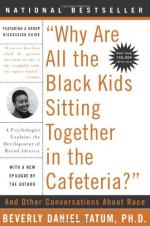
|
| Name: _________________________ | Period: ___________________ |
This test consists of 5 multiple choice questions, 5 short answer questions, and 10 short essay questions.
Multiple Choice Questions
1. What concept defined by the author holds the extended family as a reference group for social support?
(a) Familism.
(b) Miscegenation.
(c) Matrilineality.
(d) Marginalization.
2. Puerto Rico is Spanish for what phrase?
(a) Bountiful fruit.
(b) Sandy beaches.
(c) No worries.
(d) Rich port.
3. What refers to independence or freedom, as of the will or one's actions?
(a) Annihilation.
(b) Catharsis.
(c) Antagonist.
(d) Autonomy.
4. According to the author in Part III, Understanding Whiteness in a White Context, Chapter 6, The Development of White Identity, whites are initially unaware how the internalization and socialization of what has affected them?
(a) Nativism.
(b) White nationalism.
(c) Racism.
(d) Contact.
5. The first Ku Klux Klan flourished in the South in what era?
(a) 1900s.
(b) 1860s.
(c) 1920s.
(d) 1880s.
Short Answer Questions
1. In the United States, what term is in official use and defined as a person of Cuban, Mexican, Puerto Rican, South or Central American, or other Spanish culture or origin regardless of race?
2. In what year did Virginia law state that to be defined as "mulatto," a person had to have at least one-quarter African ancestry?
3. What was a case in which the US Supreme Court affirmed that Alabama's anti-miscegenation statute was constitutional?
4. What was a landmark decision of the US Supreme Court that declared state laws establishing separate public schools for black and white students unconstitutional?
5. Who signed Executive order 11246?
Short Essay Questions
1. What do productive racial dialogues promote, according to the author in Part V, Breaking the Silence, Chapter 10, Embracing a Cross-Racial Dialogue?
2. How does the author suggest we as individuals seek the courage to open racial dialogues in Part V, Breaking the Silence, Chapter 10, Embracing a Cross-Racial Dialogue?
3. What is the first ethnic/racial group that the author addresses in Part IV, Beyond Black and White, Chapter 8, Critical Issues in Latino, American Indian, and Asian Pacific American Identity Development? Who comprises this group?
4. What conceptions of affirmative action does Tatum distinguish between in Part III, Understanding Whiteness in a White Context, Chapter 7, White Identity and Affirmative Action?
5. What are the advantages of affirmative action, according to the author in Part III, Understanding Whiteness in a White Context, Chapter 7, White Identity and Affirmative Action?
6. What problems does Tatum discuss which can result from the different concepts of affirmative action in Part III, Understanding Whiteness in a White Context, Chapter 7, White Identity and Affirmative Action?
7. How does the author describe differences between males and females in biracial identity formation in Part IV, Beyond Black and White, Chapter 9, Identity Development in Multiracial Families?
8. What does Beverly Tatum believe regarding racial dialogue in America, as discussed in Part V, Breaking the Silence, Chapter 10, Embracing a Cross-Racial Dialogue?
9. How does the author assert whites learn about racism in Part III, Understanding Whiteness in a White Context, Chapter 6, The Development of White Identity?
10. What is Tatum's response when white individuals in her seminars present reverse discrimination in regards to affirmative action in Part III, Understanding Whiteness in a White Context, Chapter 7, White Identity and Affirmative Action?
|
This section contains 1,011 words (approx. 4 pages at 300 words per page) |

|




